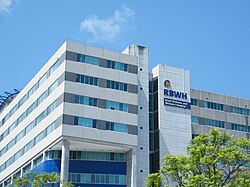Royal Brisbane and Women's Hospital
| Royal Brisbane and Women's Hospital | |||||||||||||||
|---|---|---|---|---|---|---|---|---|---|---|---|---|---|---|---|
| Queensland Health | |||||||||||||||
 | |||||||||||||||
 | |||||||||||||||
| Geography | |||||||||||||||
| Location | Butterfield Street, Herston, Queensland, Australia | ||||||||||||||
| Coordinates | 27°26′49″S 153°01′42″E / 27.4469°S 153.0283°ECoordinates: 27°26′49″S 153°01′42″E / 27.4469°S 153.0283°E | ||||||||||||||
| Organisation | |||||||||||||||
| Care system | Public Medicare (AU) | ||||||||||||||
| Type | Teaching, tertiary referral | ||||||||||||||
| Affiliated university | University of Queensland | ||||||||||||||
| Services | |||||||||||||||
| Emergency department | Yes | ||||||||||||||
| Beds | 929[1] | ||||||||||||||
| Helipads | |||||||||||||||
| Helipad | (ICAO: YRBC & YRBH) | ||||||||||||||
| |||||||||||||||
| History | |||||||||||||||
| Former name(s) |  RBWH with Beattie burger logo (2000-2012 Queensland Government corporate identity), still used on the building, and for the RBWH hospital site, rather than the wider Metro North Hospital and Health Service, which also includes other hospitals RBWH with Beattie burger logo (2000-2012 Queensland Government corporate identity), still used on the building, and for the RBWH hospital site, rather than the wider Metro North Hospital and Health Service, which also includes other hospitals | ||||||||||||||
| Opened | 2003 as Royal Brisbane and Women's Hospital | ||||||||||||||
| Links | |||||||||||||||
| Website | http://www.health.qld.gov.au/rbwh/ | ||||||||||||||
| Lists | Hospitals in Australia | ||||||||||||||
The Royal Brisbane and Women's Hospital is a tertiary hospital located in Herston, a suburb of Brisbane, Queensland, Australia. It is operated by Queensland Health, a department of the Queensland Government.[2] The hospital has 929 beds,[1] and it is estimated that 65% of the patients served come from within 15 kilometres (9.3 mi) of the hospital. It is the second largest hospital in Australia.[3]
The Royal Brisbane and Women's Hospital campus is home to several research institutes:
- QIMR Berghofer Medical Research Institute
- The University of Queensland's Centre for Clinical Research
- Brisbane Diamantina Health Partners
It is the major teaching hospital in Queensland.[4]
History[]
The main building of the Bowen Hospital as it was initially known, was designed by Charles Tiffin and others.[5] For a time it was also known as Brisbane General Hospital. In the 19th century the hospital dealt with some severe cases of tropical diseases due to Queensland's predominately tropical climate.[5]
The hospital was created by the merging of the Royal Brisbane Hospital and the Royal Brisbane Women's Hospital in 2003.[6] In the same year the hospital precinct was listed on the Queensland Heritage Register.[7]
In January 2008 there was a public health scare over concerns about lead levels at the Royal Brisbane and Women's Hospital. Lead tests carried out at a Brisbane hospital found levels were safely below recommended standards. Queensland Health said there was no need to worry about children being exposed to lead at the Royal Brisbane and Women's Hospital after air and surface swabs returned results below the levels recommended by the Environmental Protection Agency (EPA).[8]
In February 2008 the hospital was hit by a "super bug" outbreak. The bacteria, known as Vancomycin resistant enterococci or VRE. The hospital closed two 30-bed wards to new admissions in early December after 21 patients tested positive to VRE. Medical staff were forced to take extreme measures to stop the bacteria spreading.[9]
See also[]
References[]
- ^ Jump up to: a b "About Us". Queensland Health. Retrieved 19 January 2014.
- ^ "The Royal Brisbane and Women's Hospital". Queensland Health. Archived from the original on 28 November 2020. Retrieved 28 November 2020.
- ^ Jamie Walker (7 March 2020). "'Coronavirus: Tent city rises to treat patients who've tested positive". The Australian. NewsCorp. Retrieved 12 May 2020.
- ^ "History of Royal Brisbane and Women's Hospital". Royal Brisbane and Women's Hospital. Archived from the original on 28 November 2020. Retrieved 28 November 2020.
- ^ Jump up to: a b de Vries, Susanna; Jake de Vries (2003). Historic Brisbane: Convict Settlement to River City. Brisbane, Australia: Pandanus Press. p. 70. ISBN 0-9585408-4-5.
- ^ "History of the Royal Brisbane and Women's Hospital". Queensland Health. 20 August 2009. Retrieved 19 January 2014.
- ^ "Brisbane General Hospital Precinct (entry 601903)". Queensland Heritage Register. Queensland Heritage Council. Retrieved 6 July 2013.
- ^ "Hospital lead levels 'no cause for concern'" (Web article). Brisbane Times. Retrieved 12 February 2008.
- ^ Miles, Janelle. "Hospital hit by super bug outbreak". News.com. Archived from the original (News article) on 13 February 2008. Retrieved 12 February 2008.
| Wikimedia Commons has media related to Royal Brisbane and Women's Hospital. |
- Hospitals in Brisbane
- Teaching hospitals in Australia
- Hospitals established in 2003
- Herston, Queensland
- 2003 establishments in Australia
- Organisations based in Australia with royal patronage
- Royal Brisbane Hospital
- Australian hospital stubs
- Queensland building and structure stubs
- Brisbane stubs
